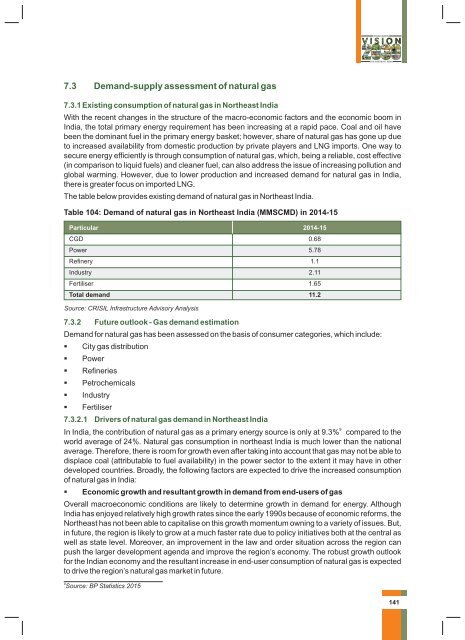Hydrocarbon Vision 2030 (ஹைட்ரோகார்பன் தொலைநோக்கு ஆவணம் 2030)
Create successful ePaper yourself
Turn your PDF publications into a flip-book with our unique Google optimized e-Paper software.
7.3 Demand-supply assessment of natural gas<br />
7.3.1 Existing consumption of natural gas in Northeast India<br />
With the recent changes in the structure of the macro-economic factors and the economic boom in<br />
India, the total primary energy requirement has been increasing at a rapid pace. Coal and oil have<br />
been the dominant fuel in the primary energy basket; however, share of natural gas has gone up due<br />
to increased availability from domestic production by private players and LNG imports. One way to<br />
secure energy efficiently is through consumption of natural gas, which, being a reliable, cost effective<br />
(in comparison to liquid fuels) and cleaner fuel, can also address the issue of increasing pollution and<br />
global warming. However, due to lower production and increased demand for natural gas in India,<br />
there is greater focus on imported LNG.<br />
The table below provides existing demand of natural gas in Northeast India.<br />
Table 104: Demand of natural gas in Northeast India (MMSCMD) in 2014-15<br />
Particular 2014-15<br />
CGD 0.68<br />
Power 5.78<br />
Refinery 1.1<br />
Industry 2.11<br />
Fertiliser 1.65<br />
Total demand 11.2<br />
Source: CRISIL Infrastructure Advisory Analysis<br />
7.3.2 Future outlook - Gas demand estimation<br />
Demand for natural gas has been assessed on the basis of consumer categories, which include:<br />
City gas distribution<br />
Power<br />
Refineries<br />
Petrochemicals<br />
Industry<br />
Fertiliser<br />
7.3.2.1 Drivers of natural gas demand in Northeast India<br />
9<br />
In India, the contribution of natural gas as a primary energy source is only at 9.3% compared to the<br />
world average of 24%. Natural gas consumption in northeast India is much lower than the national<br />
average. Therefore, there is room for growth even after taking into account that gas may not be able to<br />
displace coal (attributable to fuel availability) in the power sector to the extent it may have in other<br />
developed countries. Broadly, the following factors are expected to drive the increased consumption<br />
of natural gas in India:<br />
Economic growth and resultant growth in demand from end-users of gas<br />
Overall macroeconomic conditions are likely to determine growth in demand for energy. Although<br />
India has enjoyed relatively high growth rates since the early 1990s because of economic reforms, the<br />
Northeast has not been able to capitalise on this growth momentum owning to a variety of issues. But,<br />
in future, the region is likely to grow at a much faster rate due to policy initiatives both at the central as<br />
well as state level. Moreover, an improvement in the law and order situation across the region can<br />
push the larger development agenda and improve the region’s economy. The robust growth outlook<br />
for the Indian economy and the resultant increase in end-user consumption of natural gas is expected<br />
to drive the region’s natural gas market in future.<br />
9<br />
Source: BP Statistics 2015<br />
141

















